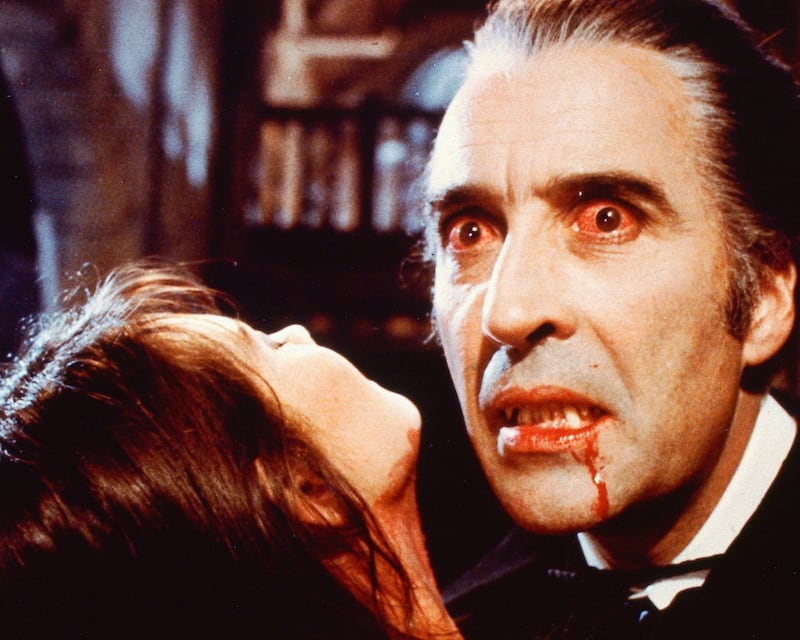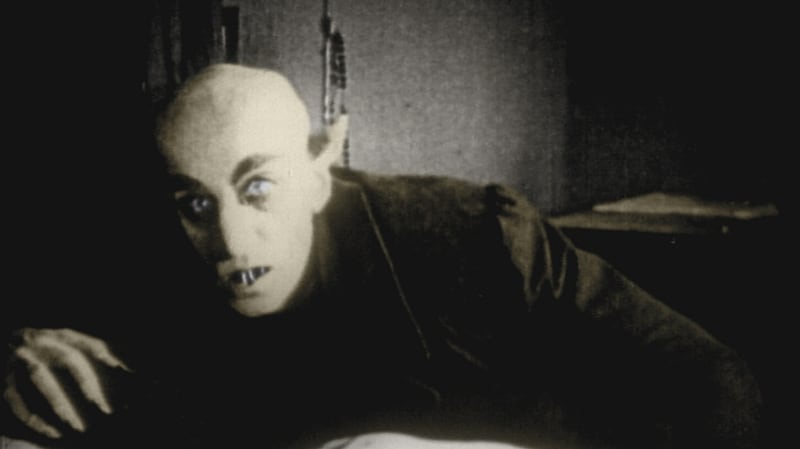There is some dispute as to what character has been represented most often on film and television. Sherlock Holmes is a strong contender. But the last time Guinness World Records did the sums, a character created just a decade after the detective took the title. Back in 2012, the beer-financed superlative almanac reckoned Count Dracula had appeared in some 272 productions. There have been plenty more since. Last year there were five Draculas on film and TV (none particularly distinguished). In August, Irish actors Aisling Franciosi and Liam Cunningham will be escorting Javier Botet’s Count across the waves in the Last Voyage of the Demeter.
Before then, Nicolas Cage finally gets to ... do I dare say “sink his teeth into the role”? Too late now. Thirty-five years after stretching the boundaries of camp in Vampire’s Kiss, that actor stars opposite Nicholas Hoult in a diverting horror comedy called Renfield. Hoult stars as the pathetic eponymous factotum – always hungry for insects and rodents – now helping his master adjust to contemporary New Orleans.
The actors have come together to help us figure out why Dracula has remained such a potent force in film over the last century. Scholars of Bram Stoker’s 1897 novel rejoice in pointing out that few film adaptations reveal more than a nodding acquaintance with the original story. Stoker’s description of the Count certainly doesn’t suggest the sub-Marilyn Manson that Cage amusingly inhabits in the new film. “Within stood a tall old man, clean-shaven with a long, white moustache,” Stoker writes in chapter two. A few pages later we learn he was “aquiline, with high bridge of the thin nose and peculiarly arched nostrils; with lofty domed forehead and hair growing scantily round the temples but profusely elsewhere”.
You can’t imagine Bela Lugosi with a long, white moustache. Christopher Lee did sprout healthy hair beneath his nose for Jess Franco’s Count Dracula in 1970, but that was tidied away when he returned to the role for Hammer a few years later. Certainly no major film has risked the “pointed beard” Dracula achieved by chapter 11 of Stoker’s book. The very thought!
Dancing with the Stars: ‘I’ve had the best time of my life. I feel super fit,’ chef Kevin Dundon says as he is voted off show
Oscars 2025 red carpet: Ariana Grande sets the standard while Timothée Chalamet stood out in ‘Kerrygold’ yellow
Róisín Ingle puts a Thermomix to the test: ‘I am a convert but there’s one enormous catch’
Dracula is a character that has this bloodlust addiction. You supplant one addiction – like alcohol or heroin or sex – with blood and we can relate to that
— Nicolas Cage
Nonetheless, some spirit of the original Dracula has taken us from early silent movies right up to the current rambunctious entertainment. Stoker was working with ancient myth, but his version, arriving almost simultaneously with the birth of cinema, codified the traditions for an emergent, hungry medium.
“I think Dracula is a character who lends itself to the human experience – even though it’s supernatural,” says Cage, looking trim and fresh in his 60th year. “He’s a character that has this bloodlust addiction. You supplant one addiction – like alcohol or heroin or sex – with blood and we can relate to that. And then you also have this idea of eternal existence as an undead, meaning that he’s going to always get his heart broken or be betrayed again. And again and again. And I think that’s the curse of Dracula, which is also a human experience.”
Nicholas Hoult, who plays Renfield as the therapy-friendly victim of a toxic relationship, also has no trouble accommodating the source material to contemporary concerns.

“The core of everything they’re experiencing is very relatable to us – regardless of supernatural elements of the story or when it’s set,” he says. “Renfield has this idea of regret, remorse and being trapped, but also of being charmed by Dracula.”
The temptation is to argue that every age gets the Dracula it needs and desires. That cliche always hinges up in its coffin during such conversations. And, sure enough, you can see something of the post-first World War despair in the verminous figure portrayed by Max Schreck – renamed as Count Orlok – in 1922 for FW Murnau’s Nosferatu. Almost lost to the world following a rights dispute with Stoker’s widow, that daring expressionist film remains the most critically lauded “adaptation” of the story (contrary to legend, the intertitles did acknowledge Dracula as a source). The contemporaneously set Christopher Lee sequels to Hammer’s Dracula in the 1970s – Dracula AD 1972 and The Satanic Rites of Dracula – saw the British studio struggling to catch up with the swinging movements of the previous decade. Blacula, another 1972 release, hopped on the Blaxploitation craze.
When children dress up as Dracula for Halloween, they still wear a version of an evening dress and opera cape
No organisation has been more concerned with adapting the yarn to the current zeitgeist than Universal Studios. That company brought Bela Lugosi to the role for Tod Browning’s 1931 film. One might reasonably argue that the Hungarian actor’s incarnation, derived from an enormously successful play, was the one that cast the longest shadows. When children dress up as Dracula for Halloween they still wear a version of an evening dress and opera cape. The blood and fangs came a bit later. But central European formal wear remains the default setting for every generation’s Dracula. Anything else looks like “a departure”.
With accompanying versions of Frankenstein, The Mummy and The Wolfman, Universal were so successful in formalising the yarns that many of their inventions are now taken as ancient lore. Eighty years after that first burst of horror success, the studio drove me to a remote set in outer Belfast to talk to the cast of the film that was ultimately released as Dracula Untold in 2014. Luke Evans, a booming Welsh star, appeared in an origin story that took us back to the Carpathian mayhem Francis Ford Coppola had also explored in his luscious, kitchen-sink-and-all Bram Stoker’s Dracula from 1992. Evans shuddered at talk of Lugosi, Lee and Gary Oldman, star of the Coppola film.
[ The Movie Quiz: Who has appeared in the most films playing BatmanOpens in new window ]
“Oh did you have to mention those names?” he bellowed. “He is, of course, one of Universal’s oldest monsters. They released Dracula in 1931. He has been played by some of the greatest actors alive. There’s a sense of pressure. I feel that with every job. There is a responsibility to try something new.”
By the time Dracula Untold was unveiled, Universal was adapting more to commercial than cultural imperatives. We were now in the era of the hyper-franchises: entire universes built around Marvel characters, Fast & Furious petrolheads and Star Wars galaxies. They remade The Wolfman with Benicio del Toro. Evans had his crack at Dracula. The attempt to introduce a whole Dark Universe empire with The Mummy – that thing with Tom Cruise and Russell Crowe – led to a miserable nowhere.
[ Dungeons & Dragons: Honour Among Thieves – Unpromising material, great filmOpens in new window ]
Happily, the studio saw sense and moved on with the excellent, raw-boned The Invisible Man in 2020 and, now, the harmlessly rambunctious Renfield. The great horror scholar Kim Newman – also the author of the fine Anno Dracula series of novels – astutely homes in on the once-vogueish variations that Chris McKay resists. “After decades of vampires who fall into the doomed-romantic or feral-junkie categories, Cage gives us a Dracula who’s evil on all levels,” he writes. How true. For some time, filmmakers have enjoyed twisting Dracula into either Byron (Lord) or Burroughs (William S). This uncomplicated comedy allows Cage to bare fangs and tear at the scenery as only he can. The film does get at modern therapy culture, but Cage’s Dracula is largely uncomplicated by sociological re-readings. Yet he and Hoult are respectful to the heritage. Cage talks of Hammer’s films from the 1950s and 1960s.
“I favour Christopher Lee as Dracula,” says Cage in his trademark rumble. “I liked his appearance. I liked the 1960s hairdo. I like the clothes. I liked the Hammer Horror thing. He was my Dracula. And I think, though not actually Dracula, Orlok in Nosferatu was really compelling. When I saw that at five it was very scary.”

Hoult looks back to the Universal film and the character actor who proved such a useful murderous supporting player.
“Bela Lugosi is my favourite Dracula and also, from that film, Dwight Frye is also my favourite Renfield. That was something that I went back and watched a lot. I’d have his laugh playing in my headphones on set. I carried that with me and peppered it in occasionally throughout the story.”
Cage hops on the Frye bus.
“I was just going to say I thought Dwight Frye was the best thing in that Dracula,” he says. “I thought that performance was magnificent. And, then again, I think what Nick does with the Renfield character is brand new. I don’t think we’ve seen this kind of interpretation ever before.”
[ ‘I’d do it again’: Jeremy Renner gives first interview since snowplough accidentOpens in new window ]
It hardly needs to be said that the fascination with Dracula shows no sign of ebbing. Whatever about any particular era’s needs and desires, the motivations of the core character have remained consistent throughout. Those were largely formed in the novel. But they were also shaped by the defining screen versions from the 1920s and the 1930s. Werner Herzog remade Murnau’s film as Nosferatu the Vampire in 1979. As we speak, Robert Eggers, he of The Northman and The Lighthouse, is directing Bill Skarsgård as the lead in a third version. None other than Nicholas Hoult is also on board.
When I talked to Eggers a year ago, he wasn’t sure it was still happening.
“It’s fallen apart twice and maybe Murnau’s ghost was saying: ‘What are you doing, buddy? I let Herzog get away with it because of his place in German cinema history.’ Let’s just do something else? I don’t know.”
The production soon emerged from its temporary crypt. Shooting began in Prague last month. Dracula is hard to kill.
Renfield is released on April 14th




















